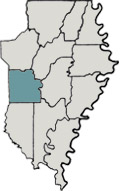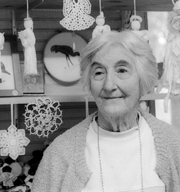Introduction to Delta Pieces: Northeast Louisiana Folklife
Map: Cultural Micro-Regions of the Delta, Northeast Louisiana

The Louisiana Delta: Land of Rivers








Ethnic Groups










Working in the Delta








Homemaking in the Delta





Worshiping in the Delta



Making Music in the Delta




Playing in the Delta







Telling Stories in the Delta



Delta Archival Materials
Bibliography

Helen Lyke
Caldwell Parish
Helen Lyke learned from her mother how to crochet, embroider, do drawn threadwork, and can vegetables and fruit.

Helen Lyke: Passing On Family Traditions From Needlework To Stories
By Sylvia Frantom
Helen Lyke learned from her mother how to crochet, embroider, do drawn threadwork, and can vegetables and fruit. Helen Lyke was born December 7, 1914 at the Martin Homeplace in Columbia, Louisiana, in the same house where her mother was born. Lyke's grandparents, George and Ann Martin, built the house in the 1880s and raised 11 children there. The Martin Homeplace was purchased by the Louisiana Art and Folk Festival and is listed in the National Register of Historic Places. Helen Lyke grew up in Monroe, Louisiana, as a child and moved next door to the Martin Homeplace and lived there until her death on February 7, 2000. She had warm memories of the Martin Homeplace and had interesting stories about the time the place flooded in 1927.
Needlework
An accomplished seamstress, Helen Lyke's mother crocheted the lace she sewed on dresses, the bottom of petticoats, the edges of dresser and table scarves, and pillow cases. She also crocheted lace collars, yokes for gowns, and doilies. Lyke was rather certain that her mother learned this from her mother also. Helen Lyke explains the traditional women's work at the time: "Back then they didn't go like people do now. They didn't have a car to take off in so they stayed home and did handwork." Lyke felt that her mother crocheted mainly in the winter because she would be busy with gardening and canning in the summer. Lyke learned by watching her mother crochet and then practiced by herself. If it wasn't done correctly, her mother would make her "pull it out and do it right." But she said it wasn't hard to learn.
Helen Lyke crocheted snow flakes and angels for Christmas tree decorations and sold them in the Martin Homeplace Gift Shop for one or two dollars each in 1994. She crocheted doilies and lace for the edges of dresses or to use as table scarves for herself or relatives. She used a #7 crochet hook just like her mother; she kept her mother's crochet hooks to use. Lyke used "Bedspread Crochet Cotton" brand and preferred 10, 20 or 30 size thread. Her mother could buy thread at a general store as far back as she could remember. Lyke heard that people ripped the thread from old flour or sugar sacks to use for crocheting, which she thinks her mother probably did. Lyke used the same stitches her mother taught her, but she often used different patterns. She said she started off with a chain stitch, then did a double crochet, and then a treble. She liked to crochet tightly, sometimes so much so that she had trouble getting the hook through.
Helen Lyke's mother also taught her to do drawn threadwork. Her mother used it for scarves for dressers and tables and for aprons. Drawn work is called by that name because some of the threads are actually pulled out of the fabric. Lyke took some woven fabric and counted a certain number of threads and then she would cut them and pull them out. This created a vacant space in the fabric. She used the buttonhole stitch to keep the fabric from raveling. Different colors of embroidery thread are used for binding according to the design she wanted to create.
Other handwork her mother taught her included embroidery, knitting, and piecing quilts. She knitted sweaters and little stuffed rabbits and she embroidered table scarves, pillow cases and aprons. Helen Lyke said she liked to sew because it relaxed her and gave her the opportunity to make gifts for family members.
Canning
Food preservation was another skill Helen Lyke's mother taught her. In the summer, she and her mother canned string beans, tomatoes, and other vegetables. She said that canning "really helped out on the grocery bill. Then in the winter, we would have string beans and tomatoes that you couldn't get in the store like you do now." She said that the most important thing when canning is to use fresh fruit or vegetables that are not overly ripe. Lyke watched and learned how to can fruit and preserves; they even canned a yearling (a one-year-old bull or heifer) in fall or winter. She and her mother dried fruit by peeling and slicing it and then placing it outside in the sun to dry. Over the years, better cook stoves improved many Columbia kitchens. First they used a wood burning stove, then a kerosene stove, and later a gas stove.
Memories of the 1927 Flood
When the flood of 1927 occurred Helen Lyke was a child living in Monroe, but she remembers stories she heard from her family living in Columbia near the Ouachita River. The Martin Homeplace flooded when the river overflowed; her grandmother, aunt, two uncles and a cousin living there at the time had to move their livestock to the hills about two miles away by driving the cattle there, but when the water started rising they had to transport them by boat. The Martins also built platforms near the house for their chickens and every day they would go back to the homeplace to feed them.
Helen Lyke relates her family's experiences during the flood of 1927 when around 12 inches of water crested inside the Martin Homeplace:
They had to take all of their livestock and move it across the river to the hills. Then my grandmother, aunt, and two uncles lived here [in the house] and they had to go out [to the hills too.] They said it got about 12 inches in the house. That was the 1927 flood. My uncle said that he had come back here one time and there was a big trout had gotten in the house. A big fish! And he finally caught him. And they had fish [for supper.] Before [the water] got into the house, [but while the water was still rising] my grandmother said that they would sit on the back porch and fish. She said they caught some of the prettiest bream.
Helen Lyke learned many useful arts and skills from her mother, and shared them with her friends, family and visitors to the Martin Homeplace. However, she felt she could have done more to learn from her family. Helen Lyke reflected on the past and said, "There are a lot of things I wish I'd paid more attention to, but I don't think we realize that until it's too late."




